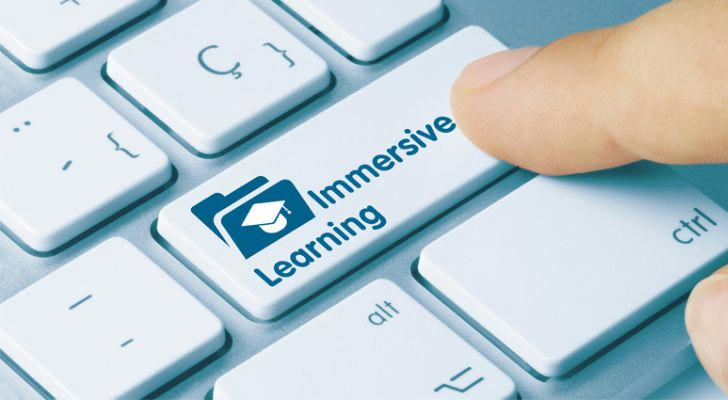What role does immersion play in language learning?

Diving into the heart of language learning, immersion emerges as a transformative approach, fundamentally altering the learner's experience. By enveloping oneself in the language's natural habitat, whether through travel, media, or cultural exchanges, comprehension and fluency see exponential growth.
This essay posits that immersion is indispensable, serving as a catalyst for not only linguistic mastery but also a deeper appreciation of cultural nuances, fostering a holistic learning journey.
Define immersive learning
Immersive learning is a potent educational strategy that integrates learners into an environment where the subject of study is omnipresent, fostering a deep, experiential understanding. This approach comes in three primary forms: full immersion, where the target language or subject is used exclusively; partial immersion, blending native and target languages or subjects; and virtual immersion, leveraging technology to simulate immersive experiences.
The purpose of immersion learning is to help learners acquire the language faster while improving listening, speaking, reading and writing skills by simulating real-world language use situations. This approach also helps learners better understand and absorb the cultural context of the target language.

Challenges and solutions in immersive learning
Immersive learning environments are known for their deep engagement and experiential learning, but they also encounter some common challenges, especially when learners are placed in a non-native language or non-native cultural environment. Here are some common challenges and corresponding solutions:
Challenge 1: Language Anxiety
When learners are asked to communicate in a non-native language, they may feel anxious or unconfident. This language anxiety may stem from concerns about pronunciation, grammatical errors, or inability to express fluently.
Solutions:
1.Progressive Immersion: Start with simple conversations and gradually increase the difficulty to allow learners to gradually adapt to the target language environment.
2.Encouraging Feedback: Positive feedback from teachers and peers can enhance learners' confidence and reduce language anxiety.
3.Role Playing and Gamification: Through role-playing and gamified learning activities, learners can practice language in a relaxed atmosphere and reduce the pressure of formal communication.
Challenge 2: Cultural Barriers
Cultural differences may lead to communication misunderstandings and affect learners' experience in immersive environments. Learners may have difficulty understanding or adapting to the customs, values, and behavioral norms of the target culture.
Solutions:
1.Cultural education: Provide education on cultural background knowledge to help learners understand the core values, customs, and behavioral patterns of the target culture.
2.Cross-cultural communication skills training: Train learners to communicate effectively in a cross-cultural environment through simulated scenarios and discussions.
3.Peer support: Establish a mentor system consisting of native speakers and experienced peers to provide cultural guidance and language support.
Challenge 3: Technical barriers
In a virtual immersive learning environment, technical issues may become an obstacle and affect the learning experience.
Solutions:
1.Technical training: Provide necessary technical training to ensure that learners can use immersive learning tools and platforms proficiently.
2.Technical support: Set up a dedicated technical support team to solve problems encountered by learners in the process of using technology at any time.

Real-Life Examples of Successful Language Acquisition Through Immersion
Beyond Words VR: Virtual Reality Language Learning Platform
Beyond Words VR is a platform that utilizes virtual reality technology to create immersive language learning experiences. Users can explore different cities and cultures while engaging in conversations with native speakers, which greatly enhances the learning process.
This type of immersion allows learners to practice language skills in contextually relevant situations, making the learning more authentic and effective.
DC Teacher's Fluent English Journey
DC teacher, also known as Chun Deng, has shared her personal experience of becoming fluent in English through immersion. She started by having an excellent English tutor from a young age, continued studying English throughout her education, and incorporated English into her daily life by reading magazines, speaking early, and listening to music. Her study abroad experiences further solidified her language proficiency.
DC's method includes trying to understand information in English first, bravely expressing herself in English, and using entertainment to cultivate language intuition.
These success stories highlight the power of immersion in language acquisition. Whether through technological platforms like Beyond Words VR or through traditional methods like study abroad and daily immersion practices, learners can achieve fluency by surrounding themselves with the target language and actively engaging with it in various contexts.
Conclusion: Embracing Immersion for Profound Language Mastery
In the dynamic realm of language learning, immersion has emerged as a profoundly effective strategy, transcending traditional methods by offering a comprehensive approach that enhances comprehension, fluency, and cultural understanding. By fully surrounding learners in the target language environment, immersion facilitates an organic, experiential learning process. This methodology not only accelerates language proficiency but also deepens one’s appreciation for the nuances of culture, enabling a richer, more authentic engagement with the language.

Immersion, whether through study abroad programs, immersion schools, or technologically advanced platforms like virtual reality environments, creates a bridge between learning and lived experience. It transforms abstract concepts into tangible realities, making the learning journey both enjoyable and highly effective. By actively participating in conversations, experiencing cultural practices firsthand, and navigating real-life scenarios, learners gain a deeper understanding and fluency in the language.
